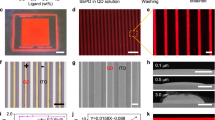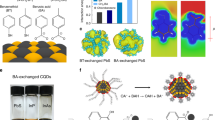Abstract
Colloidal quantum dots (QDs) stand at the forefront of a variety of photonic applications given their narrow spectral bandwidth and near-unity luminescence efficiency. However, integrating luminescent QD films into photonic devices without compromising their optical or transport characteristics remains challenging. Here we devise a dual-ligand passivation system comprising photocrosslinkable ligands and dispersing ligands to enable QDs to be universally compatible with solution-based patterning techniques. The successful control over the structure of both ligands allows the direct patterning of dual-ligand QDs on various substrates using commercialized photolithography (i-line) or inkjet printing systems at a resolution up to 15,000 pixels per inch without compromising the optical properties of the QDs or the optoelectronic performance of the device. We demonstrate the capabilities of our approach for QD-LED applications. Our approach offers a versatile way of creating various structures of luminescent QDs in a cost-effective and non-destructive manner, and could be implemented in nearly all commercial photonics applications where QDs are used.
This is a preview of subscription content, access via your institution
Access options
Access Nature and 54 other Nature Portfolio journals
Get Nature+, our best-value online-access subscription
$29.99 / 30 days
cancel any time
Subscribe to this journal
Receive 12 print issues and online access
$259.00 per year
only $21.58 per issue
Buy this article
- Purchase on Springer Link
- Instant access to full article PDF
Prices may be subject to local taxes which are calculated during checkout




Similar content being viewed by others
Data availability
All data supporting this work are contained in Figs. 1–4. Source data are provided with this paper.
Change history
10 March 2023
A Correction to this paper has been published: https://doi.org/10.1038/s41565-022-01313-y
References
Ekimov, A. I., Efros, Al. L. & Onushchenko, A. A. Quantum size effect in semiconductor microcrystals. Solid State Commun. 56, 921–924 (1985).
Brus, L. Electronic wave functions in semiconductor clusters: experiment and theory. J. Phys. Chem. 90, 2555–2560 (1986).
Colvin, V., Schlamp, M. & Alivisatos, A. P. Light-emitting diodes made from cadmium selenide nanocrystals and a semiconducting polymer. Nature 370, 354–357 (1994).
Mueller, A. H. et al. Multicolor light-emitting diodes based on semiconductor nanocrystals encapsulated in GaN charge injection layers. Nano Lett. 5, 1039–1044 (2005).
Pietryga, J. M. et al. Spectroscopic and device aspects of nanocrystal quantum dots. Chem. Rev. 116, 10513–10622 (2016).
Kwak, J. et al. Bright and efficient full-color colloidal quantum dot light-emitting diodes using an inverted device structure. Nano Lett. 12, 2362–2366 (2012).
Coe, S., Woo, W.-K., Bawendi, M. & Bulović, V. Electroluminescence from single monolayers of nanocrystals in molecular organic devices. Nature 420, 800–803 (2002).
Steckel, J. S. et al. Quantum dots: the ultimate down‐conversion material for LCD displays. J. Soc. Inf. Disp. 23, 294–305 (2015).
Bourzac, K. Quantum dots go on display. Nature 493, 283–283 (2013).
Yang, J. et al. Toward full-color electroluminescent quantum dot displays. Nano Lett. 21, 26–33 (2021).
Yang, J. et al. High-resolution patterning of colloidal quantum dots via non-destructive, light-driven ligand crosslinking. Nat. Commun. 11, 2874 (2020).
Meng, T. et al. Ultrahigh-resolution quantum-dot light-emitting diodes. Nat. Photon. 16, 297–303 (2022).
Kim, T.-H. et al. Full-colour quantum dot displays fabricated by transfer printing. Nat. Photon. 5, 176–182 (2011).
Zhao, J. et al. Large-area patterning of full-color quantum dot arrays beyond 1,000 pixels per inch by selective electrophoretic deposition. Nat. Commun. 12, 4603 (2021).
Triana, M. A., Hsiang, E.-L., Zhang, C., Dong, Y. & Wu, S.-T. Luminescent nanomaterials for energy-efficient display and healthcare. ACS Energy Lett. 7, 1001–1020 (2022).
Cakmakci, O. & Rolland, J. Head-worn displays: a review. J. Disp. Technol. 2, 199–216 (2006).
Jang, H. J., Lee, J. Y., Baek, G. W., Kwak, J. & Park, J.-H. Progress in the development of the display performance of AR, VR, QLED and OLED devices in recent years. J. Inf. Disp. 23, 1–17 (2022).
Nam, T. W. et al. Thermodynamic-driven polychromatic quantum dot patterning for light-emitting diodes beyond eye-limiting resolution. Nat. Commun. 11, 3040 (2020).
Choi, M. K. et al. Wearable red–green–blue quantum dot light-emitting diode array using high-resolution intaglio transfer printing. Nat. Commun. 6, 7149 (2015).
Keum, H. et al. Photoresist contact patterning of quantum dot films. ACS Nano 12, 10024–10031 (2018).
Hahm, D. et al. Surface engineered colloidal quantum dots for complete green process. ACS Appl. Mater. Interfaces 12, 10563–10570 (2020).
Azzellino, G., Freyria, F. S., Nasilowski, M., Bawendi, M. G. & Bulović, V. Micron-scale patterning of high quantum yield quantum dot leds. Adv. Mater. Technol. 4, 1800727 (2019).
Wood, V. et al. Inkjet‐printed quantum dot–polymer composites for full‐color a.c.‐driven displays. Adv. Mater. 21, 2151–2155 (2009).
Yang, P., Zhang, L., Kang, D. J., Strahl, R. & Kraus, T. High‐resolution inkjet printing of quantum dot light‐emitting microdiode arrays. Adv. Optical Mater. 8, 1901429 (2020).
Roh, H. et al. Enhanced performance of pixelated quantum dot light‐emitting diodes by inkjet printing of quantum dot–polymer composites. Adv. Optical Mater. 9, 2002129 (2021).
Chen, M. et al. High performance inkjet-printed QLEDs with 18.3% EQE: improving interfacial contact by novel halogen-free binary solvent system. Nano Res. 14, 4125–4131 (2021).
Tekin, E., Smith, P. J. & Schubert, U. S. Inkjet printing as a deposition and patterning tool for polymers and inorganic particles. Soft Matter 4, 703–713 (2008).
Ahn, J. et al. Ink-lithography for property engineering and patterning of nanocrystal thin films. ACS Nano 15, 15667–15675 (2021).
Kim, G.-H. et al. High-resolution colloidal quantum dot film photolithography via atomic layer deposition of ZnO. ACS Appl. Mater. Interfaces 13, 43075–43084 (2021).
Mei, W. et al. High-resolution, full-color quantum dot light-emitting diode display fabricated via photolithography approach. Nano Res. 13, 2485–2491 (2020).
Park, J.-S. et al. Alternative patterning process for realization of large-area, full-color, active quantum dot display. Nano Lett. 16, 6946–6953 (2016).
Wang, Y., Fedin, I., Zhang, H. & Talapin, D. V. Direct optical lithography of functional inorganic nanomaterials. Science 357, 385–388 (2017).
Wang, Y., Pan, J.-A., Wu, H. & Talapin, D. V. Direct wavelength-selective optical and electron-beam lithography of functional inorganic nanomaterials. ACS Nano 13, 13917–13931 (2019).
Cho, H. et al. Direct optical patterning of quantum dot light‐emitting diodes via in situ ligand exchange. Adv. Mater. 32, 2003805 (2020).
Ahn, S., Chen, W. & Vazquez-Mena, O. High resolution patterning of PbS quantum dots/graphene photodetectors with high responsivity via photolithography with a top graphene layer to protect surface ligands. Nanoscale Adv. 3, 6206–6212 (2021).
Pan, J.-A., Ondry, J. C. & Talapin, D. V. Direct optical lithography of CsPbX3 nanocrystals via photoinduced ligand cleavage with postpatterning chemical modification and electronic coupling. Nano Lett. 21, 7609–7616 (2021).
Mattoussi, H. et al. Self-assembly of CdSe−ZnS quantum dot bioconjugates using an engineered recombinant protein. J. Am. Chem. Soc. 122, 12142–12150 (2000).
Jeong, B. G. et al. Colorful opaque photovoltaic modules with down-converting InP/ZnSexS1–x quantum dot layers. Nano Energy 77, 105169 (2020).
Sanai, Y., Kagami, S. & Kubota, K. Cross-linking photopolymerization of monoacrylate initiated by benzophenone. J. Polym. Sci. Part A: Polym. Chem. 56, 1545–1553 (2018).
Virkar, A., Ling, M.-M., Locklin, J. & Bao, Z. Oligothiophene based organic semiconductors with cross-linkable benzophenone moieties. Synth. Met. 158, 958–963 (2008).
Qu, B., Xu, Y., Ding, L. & Rånby, B. A new mechanism of benzophenone photoreduction in photoinitiated crosslinking of polyethylene and its model compounds. J. Polym. Sci. Part A: Polym. Chem. 38, 999–1005 (2000).
Boscá, F. & Miranda, M. A. New trends in photobiology (invited review) photosensitizing drugs containing the benzophenone chromophore. J. Photochem. Photobiol. B 43, 1–26 (1998).
Dorman, G., Nakamura, H., Pulsipher, A. & Prestwich, G. D. The life of pi star: exploring the exciting and forbidden worlds of the benzophenone photophore. Chem. Rev. 116, 15284–15398 (2016).
Ko, J. et al. Direct photolithographic patterning of colloidal quantum dots enabled by UV-crosslinkable and hole-transporting polymer ligands. ACS Appl. Mater. Interfaces 12, 42153–42160 (2020).
Han, J. et al. Toward high-resolution, inkjet-printed, quantum dot light-emitting diodes for next-generation displays. J. Soc. Inf. Disp. 24, 545–551 (2016).
Kim, B. H. et al. High-resolution patterns of quantum dots formed by electrohydrodynamic jet printing for light-emitting diodes. Nano Lett. 15, 969–973 (2015).
Nallan, H. C., Sadie, J. A., Kitsomboonloha, R., Volkman, S. K. & Subramanian, V. Systematic design of jettable nanoparticle-based inkjet inks: rheology, acoustics, and jettability. Langmuir 30, 13470–13477 (2014).
Chung, S., Cho, K. & Lee, T. Recent progress in inkjet‐printed thin‐film transistors. Adv. Sci. 6, 1801445 (2019).
Hahm, D. et al. Design principle for bright, robust, and color-pure InP/ZnSexS1–x/ZnS heterostructures. Chem. Mater. 31, 3476–3484 (2019).
Jeong, B. G. et al. Interface polarization in heterovalent core–shell nanocrystals. Nat. Mater. 21, 246–252 (2022).
Acknowledgements
This study was supported by the National Research Foundation of Korea (NRF) grant funded by the Ministry of Science, ICT, and Future Planning (2020R1A2C2011478 (W.K.B.), 2021R1A2C2008332 (M.S.K.), 2020M3D1A2101310 & 2021M3H4A3A01062960 (W.K.B., M.S.K. and D.C.L.), and 2021M3H4A1A01004332 (D.C.L. and W.K.B.)); the Ministry of Trade, Industry & Energy (MOTIE, Korea) (no. 20010737 (W.K.B.) and 20015805 (J.-W.S., N.S.C. and C.K.)); and Electronics and Telecommunications Research Institute (ETRI) grant funded by the Korean government (no. 22ZB1200 (J.-W.S., N.S.C. and C.K.), Development of ICT Materials, Components and Equipment Technologies). This research was also supported by Samsung Display (W.K.B., M.S.K. and D.C.L.).
Author information
Authors and Affiliations
Contributions
D.H., J.L., H.K., C.K., M.S.K. and W.K.B. conceived the original idea and designed the experiments. D.H., J.L., J.H.C., Y.-S.P. and D.C.L. conducted the synthesis and characterization of QD and analysed the spectroscopic data. D.H., J.L., H.K., J.-W.S., J.Y., C.H.L. and C.K. prepared the dual-ligand QDs and carried out the patterning experiment and thin-film characterization. S.H. and S.C. conducted the inkjet printing and characterization. B.C. and E.H. carried out the computational calculation. J.-W.S., S.R., H.J., N.S.C. and C.K. fabricated all the devices and analysed the data. All the authors contributed to the preparation of the paper.
Corresponding authors
Ethics declarations
Competing interests
The authors declare no competing interests.
Peer review
Peer review information
Nature Nanotechnology thanks Lei Qian, Manuel Triana and the other, anonymous, reviewer(s) for their contribution to the peer review of this work.
Additional information
Publisher’s note Springer Nature remains neutral with regard to jurisdictional claims in published maps and institutional affiliations.
Supplementary information
Supplementary Information
Supplementary Notes 1–6, Figs. 1–24, Tables 1 and 2, caption for Supplementary Video 1 and references.
Supplementary Video 1
Electroluminescence of 10 × 10 RGB QD-LED arrays implementing photocrosslinked QD patterns. Real-time movie of light emission from 10 × 10 QD-LED arrays for each primary colour and RGB QD-LED array.
Source data
Source Data Fig. 1
Image source data for Fig. 1d.
Source Data Fig. 2
Numerical and image source data for Fig. 2b–f.
Source Data Fig. 3
Numerical and image source data for Fig. 3a–e,h.
Source Data Fig. 4
Numerical source data for Fig. 4a,c.
Rights and permissions
Springer Nature or its licensor (e.g. a society or other partner) holds exclusive rights to this article under a publishing agreement with the author(s) or other rightsholder(s); author self-archiving of the accepted manuscript version of this article is solely governed by the terms of such publishing agreement and applicable law.
About this article
Cite this article
Hahm, D., Lim, J., Kim, H. et al. Direct patterning of colloidal quantum dots with adaptable dual-ligand surface. Nat. Nanotechnol. 17, 952–958 (2022). https://doi.org/10.1038/s41565-022-01182-5
Received:
Accepted:
Published:
Issue Date:
DOI: https://doi.org/10.1038/s41565-022-01182-5
This article is cited by
-
Designer phospholipid capping ligands for soft metal halide nanocrystals
Nature (2024)
-
Recent Developments in Quantum Dot Light-Emitting Diodes for Skin-Attachable Electronics
Korean Journal of Chemical Engineering (2024)
-
High efficiency warm-white light-emitting diodes based on copper–iodide clusters
Nature Photonics (2023)
-
Surface passivation of intensely luminescent all-inorganic nanocrystals and their direct optical patterning
Nature Communications (2023)
-
High-resolution light-emitting devices for display applications
Science China Materials (2023)



